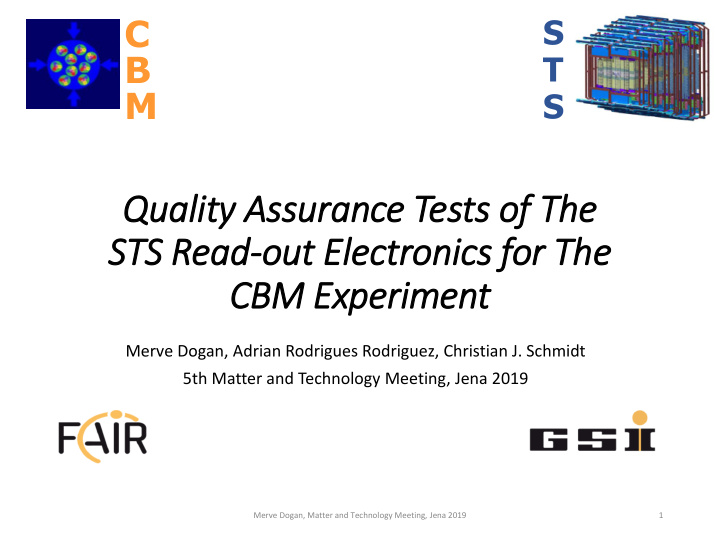



C S B T M S Quality Assurance Tests of f The STS Read-out Ele lectronics for The CBM Experiment Merve Dogan, Adrian Rodrigues Rodriguez, Christian J. Schmidt 5th Matter and Technology Meeting, Jena 2019 Merve Dogan, Matter and Technology Meeting, Jena 2019 1
• Dipol Magnet: bending charged particles trajectories • Silicon Tracking System: charged particle tracking • Micro-Vertex Detector: secondary vertex reconstruction • Ring Imaging Cherenkov: pion identification • Transition Radiation Detector: electron identification • Time of Flight Detector: hadron identification • MUon Chambers: muon identification • Electromagnetic CALorimeter: electron/photon identification • Projectile Spectator Detector: collision centrality and reaction plane determination What will be obtained Exploration of the QCD phase diagram in the region of very high baryon densities Requirements • High event rates: up to 10 MHz Au+Au reactions/seconds • Self-triggering front-end electronic • high-speed data processing • Radiation hard detectors and front-end Electronics Merve Dogan, Matter and Technology Meeting, Jena 2019 2
896 modules Silicon Tracking System Totally 106 ladders and 8-10 modules per ladder Merve Dogan, Matter and Technology Meeting, Jena 2019 3
Read-Out Elec lectronic ics STS STS-XYT XYTERv2.0 .0 (S (STS S X, X,Y Y coo oordin inate + + Time Time and and Ene Energy Reso esolu lutio ion) STS-XYTER version 2.1 is now available and under test • 128 channels+2 test channels • Chip size: approximately 10 mm x 6.7 mm • Radiation-hardened design • Energy and time measurement • Time resolution < 5ns • 5 bit flash ADC/channel dynamic range: 14fC • Digital back-end compatible with the CERN-GBTx data concentrator 4 Merve Dogan, Matter and Technology Meeting, Jena 2019
FAIR Phase 0: mCBM and mSTS mSTS • mCBM: A CBM full system test-setup for high-rate nucleus-nucleus collisions at GSI/FAIR • mSTS: demonstrator of STS intergration and operation aspects • Two mechanical half-units for the first of total two mSTS tracking stations • It will allow to test the detector and electronics components developed for the CBM experiment • Module installation has finished • First run was on December 2018, upcoming run in 2019 Merve Dogan, Matter and Technology Meeting, Jena 2019 5
Test System@GSI @GSI Clea lean Room Hardware: • Pogo pin station designed at GSI with close collaboration from Cracow team. • The pogo- socket has 53 pogo needles, each one has a diameter of ~100 µm. - Pogo station - AFCK board with STS-XYTER tester firmware. - gDPB_FMC interface card. software basen on python Which values are tested? Current values, reference voltages values, analog responses, the dynamic range for the electrons and holes before calibration 6
Basic protocol for ASIC testing 1min 5 sec 5 sec 10 sec TIMELINE Box with ASICs 3 min -In the version 2.1, possible to fuse a uniq ID in the chip at the pogo-pin test level -this information can be requisted later on as a way to track the full test of the chip from basic tests until the final system Merve Dogan, Matter and Technology Meeting, Jena 2019 7
ASIC acceptance results Number of the ASICs Number of the ASICs 339 350 300 250 200 150 100 8 5 5 1 50 0 current ADC range Before synchronization Hole electron After Configuration Total Amount of tested ASICs: 339 FEBB Tests Problematic ASIC number: 20 yield is 94 % Electrons Holes Total Number of Tested FEBs 146 Number of FEB with problematic 8 ADC Range (Register Value Units) 185 167 performance - Very high current 2 ADC Range (mV) 92.5 83.5 - No analog response 1 - No fast discriminator response 1 Amplifier Gain (ADC units/mV) 0.33 0.37 - One or more individual broken channel 4 Merve Dogan, Matter and Technology Meeting, Jena 2019 8
Functional tests during assembly TEST 2: ASIC+Microcable ➢ The goal is to check electrical connectivity between microcable and ASIC (tab-bonding quality) ➢ Measure the noise level and see the connection of channels ➢ Possible to re-bond the microcable again on ASIC side TEST 3: ASIC+Microcable+Sensor ➢ The goal is to check electrical connectivity between microcable, Sensor and ASIC (tab-bonding quality) ➢ Measure the noise level and see the connection of channels ➢ Possible to re-bond the microcable again on the sensor side Merve Dogan, Matter and Technology Meeting, Jena 2019 9
Channel hit maps reveal unconnected channels ADC Value ADC Value Channel Channel Unconnected channel i. Histograms in root ii. Read noise hit distribution Merve Dogan, Matter and Technology Meeting, Jena 2019 10
mCBM Module Assembly Status ASSEMBLY STAGE Number of tested SETUP TEST PURPOSE TIME/per Number of Bad Unconnected Asıcs REQUIREMENT ASIC ASICs Channels ASIC test 98 Pogo pin station Fully calibration & 12 min 10 test Module 01T-r 16 Pogo pin station Check electrical 5 min 3 connections Module 01T-l 8 (p-side) Pogo pin station Check electrical 5 min - connections Module 02T-r 16 (only test with Pogo pin station Check electrical 5 min 2 microcable) connections Module 02T-l 16 Pogo pin station Check electrical 5 min - connections Merve Dogan, Matter and Technology Meeting, Jena 2019 11
STS-XYTER2.0 — critical design detail ASICs showed different behaviours during the module test after assembly forthcoming module productions will be done with one ASIC test stage only. Critical lines for wire bonding 12 Merve Dogan, Matter and Technology Meeting, Jena 2019
Many thanks to my colleagues… THANK YOU! Merve Dogan, Matter and Technology Meeting, Jena 2019 13
Recommend
More recommend